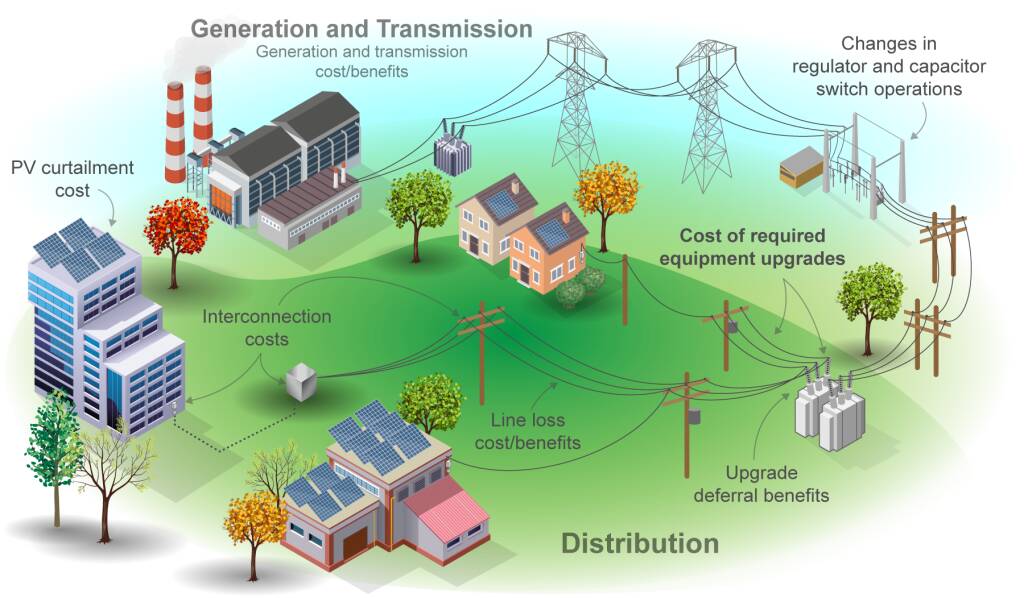Distributed Generation: The Future of Power System
The way we produce and consume electricity is changing rapidly. Traditionally, electricity has been generated in large, centralized power plants and distributed over long-distance transmission and distribution networks to homes and businesses. However, a new decentralized model of distributed generation is emerging which promises to fundamentally transform the power sector. This article explores the concept of distributed generation, its benefits, and why it represents the future of the power system.
What is Distributed Generation?
Distributed generation refers to the production of electricity from multiple small-scale units located near the end-users. These units include solar photovoltaic systems, wind turbines, combined heat and power systems, fuel cells, microturbines, and small generators powered by renewable fuels like biomass. They are installed on-site at homes, businesses, industries, and other locations to provide an alternative to or an independent source of energy compared to large central stations.
The key attributes of distributed generation are modular power ratings ranging from a few kilowatts to 10 megawatts and ability to operate independently from or interconnected with the main grid. This allows distributed energy resources to be rapidly deployed closer to customers to supplement traditional power sources or provide backup power during outages.
Benefits of Distributed Generation
Distributed generation provides numerous technical, economic and environmental benefits compared to centralized power systems. Some of the main advantages are discussed below:
Reliability and Resilience
By generating power close to end-users, distributed generation helps build a more resilient electric grid that is less prone to widespread outages from events such as storms, hurricanes or cyberattacks. It allows critical services to operate independently even during power disruptions and provides backup power to increase overall supply security.
Deferral of T&D Investments
Distributed generation helps reduce load on the transmission and distribution infrastructure by meeting a portion of demand from local sources. This can help postpone or avoid costly investments in upgrading or expanding T&D lines and substations. The siting flexibility also eases right-of-way constraints for new network extensions.
Hedging Against Fuel Price Volatility
The use of indigenous renewable resources like solar and wind eliminates fuel price risks for distributed generation. This provides a hedge against fluctuations in the market prices of imported fossil fuels used in centralized coal and gas-fired power plants.
Environmental Sustainability
When coupled with renewable technologies, distributed generation delivers significant reductions in greenhouse gas emissions, air pollution, and impacts on land, water and ecosystems compared to conventional power plants. It increases adoption of clean distributed energy technologies to decarbonize the energy sector.
Consumer Empowerment and Engagement
Distributed generation allows active participation of electricity end-users in generating their own power. This empowers consumers with greater control over their energy usage and bills. It drives new financing models for “prosumers” who can sell power back to the grid.
Distributed Generation Models and Market Trends
The diversity of distributed generation technologies has led to innovative deployment models to maximally leverage their benefits. Some of the prominent models in practice are:
On-site Generation
In this model, generation units like roof-top solar PV systems, fuel cells or wind turbines are installed at customer premises to meet a portion or all of their electricity demand. Any excess power can be fed back to the grid.
Community Solar
Shared off-site solar installations allow customers without suitable rooftops to subscribe to a portion of the system’s output. This makes solar more accessible while driving economies of scale.
Virtual Power Plants
Aggregating the output of multiple distributed energy assets creates virtual power plants that function as dispatchable flexible power sources for utilities.
Micropower Stations
Small natural gas-fired turbines or generators placed in neighborhoods produce both power and thermal energy for district heating/cooling networks.
According to industry estimates, global distributed generation capacity is expected to grow from 340 GW in 2018 to over 750 GW by 2023 led by continued expansion of solar PV, natural gas combustion turbines and fuel cells. Most growth is projected in Asia, Europe and North America as policy support accelerates.
Regulatory Developments
While distributed generation promises major economic and efficiency benefits, its large-scale integration also poses technical challenges related to power quality, stability and coordination with grid operations that need to be addressed through appropriate rules and standards.
Many jurisdictions have instituted regulatory reforms like streamlined interconnection procedures, standard contract terms, and compensation mechanisms like net metering to support distributed energy resource proliferation. Recent policy focus areas include developing markets for ancillary grid services from flexible distributed assets, setting technical performance standards, and valuing their resilience benefits.
Innovative utility business models are also exploring opportunities for distributed energy resource aggregation, virtual power plant development and asset management as the sector evolves. Supportive regulations will be key to unleash distributed generation’s tremendous potential to transform electricity systems.
Conclusion
Distributed generation represents a paradigm shift from centralized grid infrastructures to distributed, modular and connected energy networks of the future. Its emergence is driven by technological innovations, environmental imperatives as well as economic factors. With a growing role across the world, distributed energy resources will fundamentally alter the face of the power sector in the coming decades. A well-designed policy and regulatory framework can unlock even greater societal and consumer value from this transformative shift.
*Note:
1. Source: Coherent Market Insights, Public sources, Desk research
2. We have leveraged AI tools to mine information and compile it

